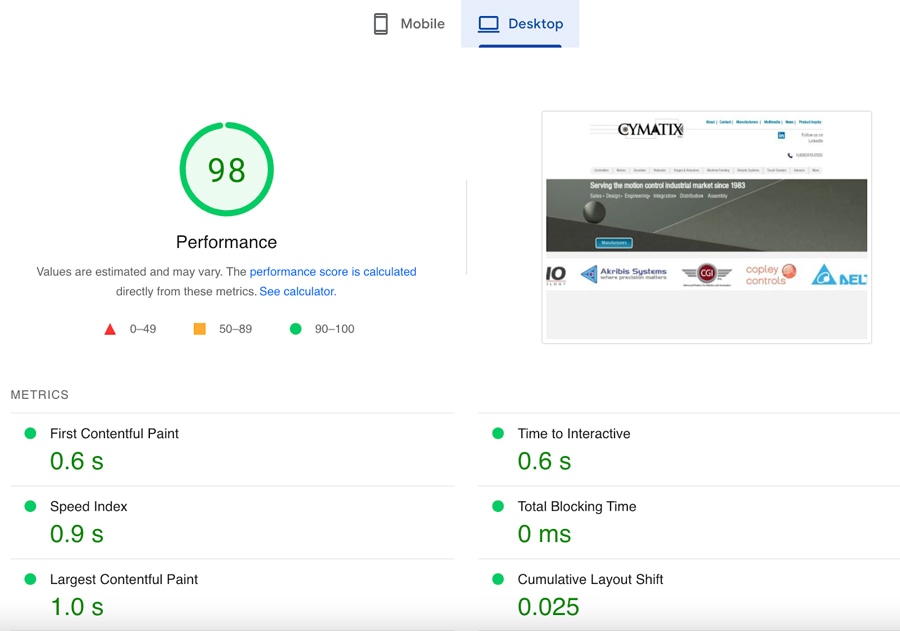5 Key Steps to Creating a Successful OEM Digital Marketing Strategy

Much of what’s written on the web about marketing is specific to B2C (business-to-consumer) marketing. While there’s also some content discussing broad-based B2B marketing, B2B digital marketing strategies for original equipment manufacturers (OEMs) and other industrial companies is unique.
In working with OEMs, we find certain common patterns that must be kept in mind when building a marketing strategy for OEMs, who typically deal with nuances such as long sales cycles, niche audiences, complex products, global reach and supply chain, multiple personas, and the need for CRM and other technical integrations. Furthermore, in the accelerating transition from traditional to digital marketing, it’s easy to feel left behind. Some key steps for getting a handle on your OEM marketing strategy, wherever you are on your trajectory toward modern marketing, are:
1. Establish benchmarks (“Know where you’re at”)
One of the first lessons in creating marketing strategies is: “You have to know where you’re at to know where you’re going.” When it comes to digital marketing strategy, this means taking a close look at your current state and asking yourself and your team some hard questions:
- Is our website presenting the information and experience that will attract the individuals and companies we’re looking to work with?
- How does Google see our website?
- How does our team view our website? Does the sales team use it in their process?
- How do our competitors have themselves positioned?
- How are our marketing efforts performing today? Use Google Analytics or SEMRush to see your performance over time.
Many manufacturing sectors tend to lag behind when it comes to digital marketing, so there’s a huge potential upside to making even small improvements that lead to outperforming your competition online.
2. Build a strong foundation with SEO, ICP and personas
Creating your SEO strategy
SEO can be broken down into three distinct areas according to how they are executed and their impact on your marketing efforts: on-page SEO, off-page SEO and technical SEO.
On-Page SEO
This is the focus of your keyword/organic strategy, and it’s arguably the most important type of SEO when you’re starting to build a strategy. You’ll want to start your plan with a target keyword list (a list of terms that you would be disappointed not to rank for, if you Googled them and didn’t see your company’s name in the results). We help our clients create this target list by evaluating a few different things:
- What is the current state of the SEO strategy? What keywords are you currently ranking for? What are you disappointed that you aren’t ranking for?
- What type of language do your customers use? Are there common industry terms you might have missed?
- Where are your competitors ranking? Are they creating content or resources that you aren’t?
Err on the side of being specific versus broad – SEO for OEMs is not about casting a wide net, but attracting a very specific group of technically-minded buyers. This article goes into more about the importance of being specific with your SEO for an industrial or OEM marketing strategy.
Once you’ve gathered your list, Google each keyword (in an incognito window or similar) and make sure that the search results pages seem like the types of content that you want to be grouped with. Then, once you’ve verified your list of keywords, you can use it to make sure each page on your website is focused around one of those target keywords. You may find that you want to create additional pages or blog articles to help elevate that ranking.
Off-Page SEO
Off-page SEO deals more with having other reputable domains link back to your website to improve your rankings. Getting listed in relevant directories, and asking other manufacturers, distributors and partners to link to your website or blog articles is an effective way to raise your website’s authority in Google’s eyes and drive quality traffic to your website. Early on in your strategy, start within your network. Once you’ve tapped that, you can begin to look at other tactics, such as submitting articles to publications.
Technical SEO
Technical SEO can be challenging. Google looks at your website not only for its information, but its performance. It’s evaluating your load time, page speed and other factors. The quickest way to evaluate your website’s technical SEO state is to run a PageSpeed report (see the example below). This report breaks down mobile performance and desktop performance, helping you see whether your website currently passes or fails its “Core Web Vitals.” If the website is failing, it’s wise to dedicate in-house or partner resources to streamline it and get that score above 90, as Google has made it clear that they will continue to prioritize high-speed, high-performing websites over low-performing ones.

Identify your ideal customer profile (ICP) and personas
Identifying your ICP—the type of company that is an ideal fit for your product or service—will help your marketing team not only generate leads but ensure that they are high-quality leads that won’t leave your sales team wasting time with a lot of qualifying discussions. Establishing personas is critical to messaging and conveying your value proposition in your content and on your website. We recommend reading about how to develop ICP and personas in a B2B context and holding a “Persona Workshop” with sales/marketing/leadership to help drill down into the 2-3 job titles that most often turn into high-quality customers. For many OEMs, your target customers are engineers or other technical folks, who will want to have as many of their questions answered by your website as possible, ahead of talking to your sales team. In order to get inside their heads and create a website and marketing strategy that really resonates, talk with your sales staff and some key customers, to answer the following:
- What questions do they ask in the sales process?
- What are their accountabilities and who are they accountable to?
- What type of content resonates most with them?
- Where do they get their information?
- What keeps them up and night, and what motivates them?
Putting these into an easy-to-read document and refining and updating them over time will arm both your marketing and sales teams with valuable perspectives when creating content.
Bonus Resource: Whitepaper – OEM Digital Marketing and SEO Leads to Success for Manufacturer
3. Aim for quick wins
To start providing instant ROI, there are a number of quick wins your team can aim for in the early stages of your OEM marketing strategy. We’ve written an article detailing some easy starters, including these:
- Run a Screaming Frog report to identify any red flags for website performance. Some examples are: Missing Page Titles, Missing H1’s, Low Content Pages. Anything flagged can be exported to a CSV/Excel file where you can see exactly which pages need fixing.
- Are there articles or pages that exist on your website that aren’t optimized around any keywords, or aren’t written to your target audience? One of the easiest ways to not have to create new content immediately is to work with and improve what you have. Are there articles you feel have a great message or are helpful resources but aren’t performing? Try changing the H1, adding additional copy and otherwise tinkering with existing pieces to get them to show up in search.
4. Identify what success looks like and how you’ll measure it
Evaluate KPIs: What are the metrics that will drive your OEM marketing strategy forward? An example would be breaking the types of metrics into categories, such as attraction and lead generation. In terms of attraction, you might want to track:
- Organic Sessions (want to always be increasing)
- Bounce Rate (want to keep this as low as possible—around 50-65% is considered high performing)
- Time On Page
While most SEO strategies tend to focus on bringing in more traffic, in the case of an OEM marketing strategy, you’re not looking to attract anyone and everyone to your website. Your aim is to attract the very specific subset of people who are likely to buy from you at some point in the future, and engage them with your content and website as a whole. That’s why it’s important to always be looking to lower the Bounce Rate and increase Time On Page even while increasing (qualified) traffic to the website, in order to improve its value and effectiveness as a marketing tool.
As companies focus more efforts on digital marketing, it’s more important than ever for sales and marketing teams to work together to have a shared understanding of what high-quality leads and successful lead generation look like. In terms of lead generation metrics, you would likely want to track:
- Conversions
- Conversion Rate
- MQLs (marketing qualified leads)
- SQLs (sales qualified leads)
- Deal Quality (quality of leads from the website)
And, of course, you’ll need tools to track and report these KPIs, which brings us to the fifth step of building a successful OEM marketing strategy.
5. Use the right tools, and report and adjust often
A full-tilt marketing strategy will have multiple people from multiple disciplines working at once. Whether or not you have the resources for that, having systems and tools to streamline the work will be impactful in reducing overhead and delivering value. These are some handy tools:
- Marketing automation software:
- HubSpot
- Marketo
- Project management software:
- Trello
- JIRA
- Monday
- SEO tools
- Screaming Frog
- SEMRush
- YoastSEO
With the right tools in place, you’ll be able to manage your workflow and get the high-quality reporting and data you need to keep your marketing moving in the right direction. Looking at your website critically and objectively, and checking progress every quarter to evaluate ongoing priorities, is vital to the success of any marketing strategy. The data sources below are those that we use to evaluate our own marketing efforts and determine our priorities for the next 90 days:
- Screaming Frog (quarterly)
- SEMRush (monthly)
- Google Analytics (daily/weekly)
- PageSpeed Insights (quarterly)
- Google Search Console (monthly/quarterly)
A simple way to manage these sources is to integrate them into Google Data Studio or a third-party dashboard that can display different views for different portions of the marketing program.
There’s a lot that goes into creating a successful OEM marketing strategy. If you take the time to ask the right questions, establish a strong foundation and remain data driven, you’ll make real progress and see success in your program.
We support OEM marketing teams with the content on our website (like this article), webinars, on-demand training courses, and through our digital marketing and website design services that are specifically tailored to industrial, manufacturing, and other technical industries, including OEMs.


